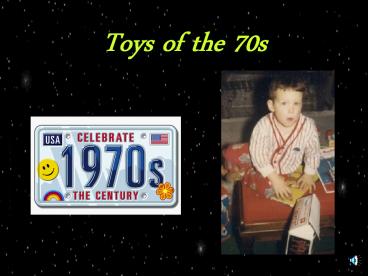Toys of the 70s - PowerPoint PPT Presentation
1 / 12
Title:
Toys of the 70s
Description:
Firmly established as a major 20th-century artist and international celebrity, ... 27, 1949, and began his Major League baseball career on September 12, 1972, with ... – PowerPoint PPT presentation
Number of Views:376
Avg rating:3.0/5.0
Title: Toys of the 70s
1
Toys of the 70s
2
Fun Fads
- Smiley Faces
- These were seen everywhere from shirts to bumper
stickers.
- Mood Rings
- The idea behind a mood ring was simple You wore
it on your finger and the color of the stone
would reflect the state of your emotions. And in
1975 it only cost 19.95 to figure out how you
were feeling . . .
3
Fun Fads
- Lave Lamps were also popular in the 70s.
- Pet Rocks were a 1975 fad originated in
California by salesman, Gary Dahl. They spread
like wildfire to the rest of the country. Here
was a pet that took no care and still gave its
owner a few moments of pleasure.
4
- George Lucas and the merchandizing deal with 20th
Century Fox - The Wilhelm
- Star Wars Thesis on toys?!
Groovy!
5
(No Transcript)
6
Electronic Games
- Pong The game that started it all. Although it
wasn't the first coin-op video game, it was the
first video game success story. Pong is
essentially a simple game of Tennis or Ping
Pong. Each player has a bat that is controlled
by a paddle, a ball bounces around the court,
and you must strike the ball with your bat, and
send the ball off towards the opposing player.
7
Electronic Games
- In 1977, Mattel put out Football 1. These were
pre-Gameboy hand-held games that basically let
the player use direction keys to run his blinking
red blip through a maze of defensive blips. A
kickoff would result in a chirping version of the
"Charge!" melody.
8
Atari
9
70s Toys
- Other Toys
10
Andy Warhol
- Andy Warhol was born Andrew Warhola in
Pittsburgh, Pennsylvania, in 1928. In 1945 he
entered the Carnegie Institute of Technology (now
Carnegie Mellon University) where he majored in
pictorial design. Upon graduation, Warhol moved
to New York where he found steady work as a
commercial artist. He worked as an illustrator
for several magazines including Vogue, Harper's
Bazaar and The New Yorker and did advertising and
window displays for retail stores such as Bonwit
Teller and I. Miller. Prophetically, his first
assignment was for Glamour magazine for an
article titled "Success is a Job in New York." - At the start of the 1970s, Warhol began
publishing Interview magazine and renewed his
focus on painting. Works created in this decade
include Maos, Skulls, Hammer and Sickles, Torsos
and Shadows and many commissioned portraits.
Warhol also published The Philosophy of Andy
Warhol (from A to B and Back Again). Firmly
established as a major 20th-century artist and
international celebrity, Warhol exhibited his
work extensively in museums and galleries around
the world.
11
Michael Jack Schmidt
- Mike Schmidt was born on Tuesday, September 27,
1949, and began his Major League baseball career
on September 12, 1972, with the Philadelphia
Phillies. The 23 year-old played for 18 seasons
on one team and ended his big league playing
career in 1989. - Stats
12
Bill Gates
- In 1973, Gates entered Harvard University as a
freshman, where he lived down the hall from Steve
Ballmer, now Microsoft's chief executive officer.
While at Harvard, Gates developed a version of
the programming language BASIC for the first
microcomputer - the MITS Altair. - In his junior year, Gates left Harvard to devote
his energies to Microsoft, a company he had begun
in 1975 with his childhood friend Paul Allen.
Guided by a belief that the computer would be a
valuable tool on every office desktop and in
every home, they began developing software for
personal computers. Gates' foresight and his
vision for personal computing have been central
to the success of Microsoft and the software
industry.































